The Great Adventure of Horus, Prince of the Sun
7 /10 1 Votes
Duration Language Japanese | 6.8/10 IMDb Country Japan | |||||||||||||||||||||||||||||||||
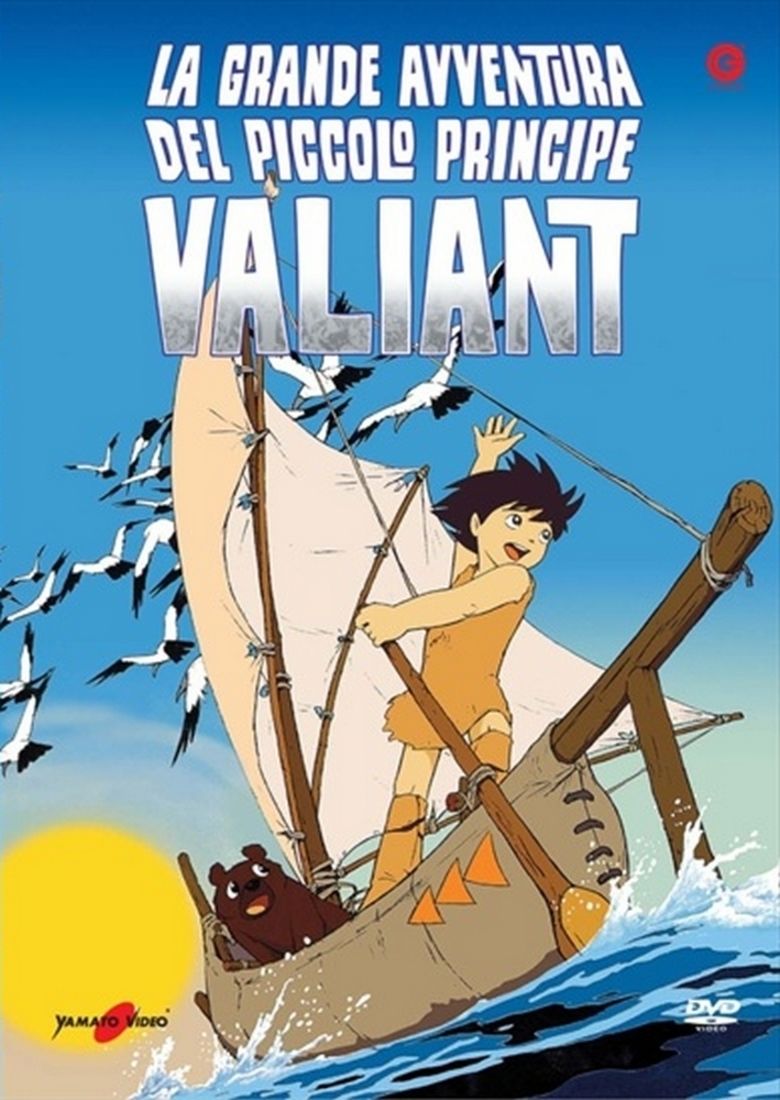 | ||||||||||||||||||||||||||||||||||
Release date July 21, 1968 (1968-07-21) | ||||||||||||||||||||||||||||||||||
The Great Adventure of Horus, Prince of the Sun (太陽の王子 ホルスの大冒険, Taiyō no Ōji Horusu no Daibōken) is an anime film released in July 1968. The directorial feature film debut of Isao Takahata, it is also the first major film by Hayao Miyazaki. Horus marked the beginning of a partnership that would last for the next 50 years across numerous animation studios.
Contents
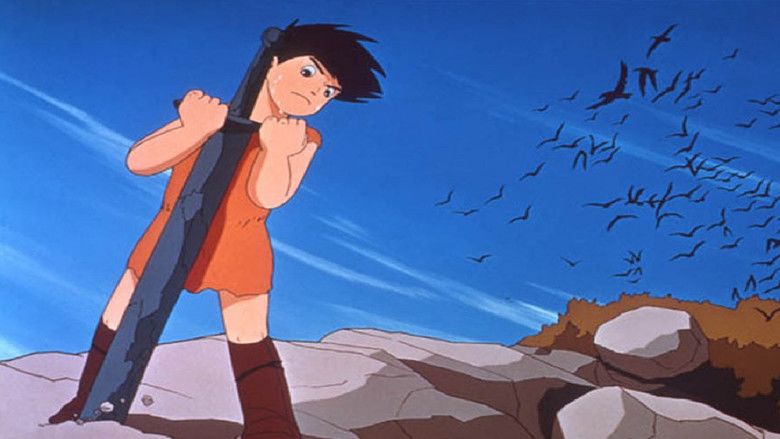
The core production team for Horus, Prince of the Sun included Takahata (Director), Yasuo Otsuka (Animation Director), Miyazaki (Scene Design, Key Animation), Yasuji Mori (Key Animation), Reiko Okuyama (Key Animation), and Yoichi Kotabe (Key Animation). This group contributed to designs, story ideas and storyboards; all but Takahata (who is not an animator) contributed to character designs. Akemi Ota, Masatake Kita, and Sadao Kikuchi were the remaining Key Animators, but did not contribute many ideas to the film.
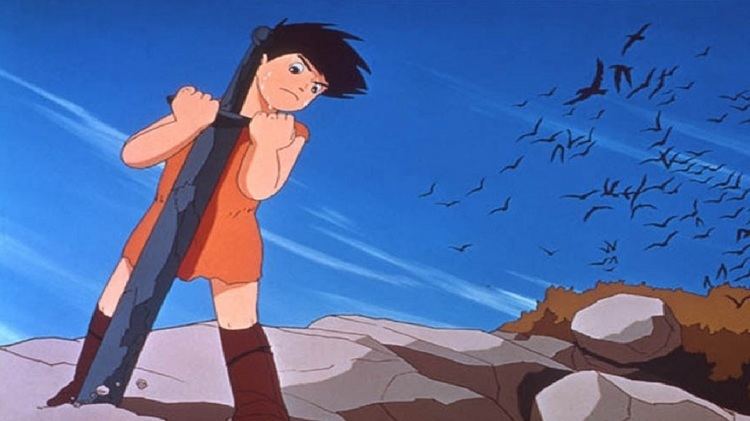
Vivid, visceral and violent, yet charged with kinetic energy, Horus introduced a number of technical and stylistic innovations, and established a new paradigm of Japanese animation: adult storytelling, psychological realism, visual complexity, overt political and social themes, and stylistic violence. This is the first Japanese animated feature to successfully disrupt the Walt Disney paradigm, and greatly expanded the possibilities of the medium beyond "children's cartoons." Unsuccessful in its original 1968 theatrical run, Horus, Prince of the Sun is today recognized as a milestone in the history of anime.

The movie was released straight to television in the United States by AIP-TV under the title The Little Norse Prince.
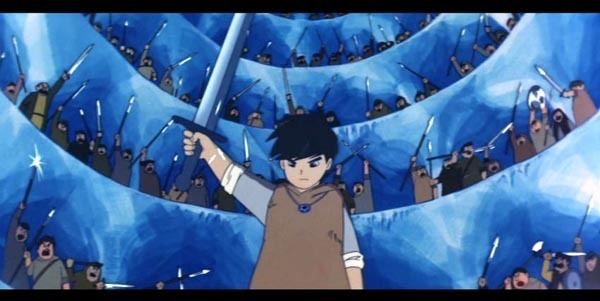
Synopsis
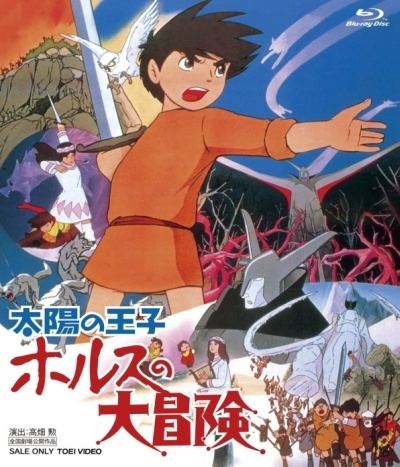
Set in an unspecified northern kingdom, the film opens with the young Horus (aka Hols) (Hisako Ōkata (Japanese)/Billie Lou Watt (English)) attempting to fight off a pack of "silver wolves," and accidentally waking up an ancient stone giant, named Mogue (or Rockoar in some editions of the film). Horus succeeds in pulling a splinter from the giant's shoulder, which transpires to be a rusty and ancient sword. The giant proclaims this to be the "Sword of the Sun," promising also that when the sword has been reforged, he will come to Horus, who will then be called "Prince of the Sun".

Horus' father, on his deathbed, reveals that their family came from a northern seaside village, which was devastated by the terrifying ice devil Grunwald, leaving them the only survivors. Before dying, Horus' father urges his son to return to the land of his birth and avenge the village.
On his journey, Horus and his companion, a bear named Koro, are soon confronted by Grunwald, who plunges the boy from a cliff when Horus refuses to serve him. Hols survives the fall and is rescued by the inhabitants of a nearby village. Horus soon becomes a heroic figure when he kills an enormous pike which had been threatening the lives and livelihoods of this fishing community.
The pike was a ploy of Grunwald's, who then sends the silver wolves to attack the village instead. In the battle that follows, Horus and Koro chase the wolves to a deserted village, where he meets a mysterious young girl named Hilda. Horus takes Hilda back to his village, where her beautiful singing is welcomed by the villagers, with the exception of the chief, who is increasingly resentful of Horus' popularity, and his deputy, Drago. Hilda, who is actually Grunwald's sister and under his evil influence, later collaborates with Drago and sends a swarm of rats to attack the village (in the original Japanese version, Grunwald wanted Horus to be his brother before he plunged Horus down the cliff; this ties in with Horus' first encounter with Hilda and her comment on how they both share the same fate that they're like twins). Drago frames Horus for his own failed attempt to assassinate the chief, and the villagers banish Horus.
Horus sets out in search of Grunwald, but is confronted by Hilda, and the owl who acts as messenger between Hilda and Grunwald. With her true identity revealed, Hilda reluctantly attack Horus, who falls into a chasm and becomes trapped in an enchanted wood, where he is haunted by visions of the villagers and his father. Grunwald then sends Hilda, against her wishes, to kill Horus, and makes his own attack on the village, together with his wolves and a giant ice mammoth.
Horus is able to escape from the enchanted forest when he realizes that the sword must be reforged as a collective effort and that the villagers must unite in order to defeat Grunwald. After a brief fight with Hilda, who is thoroughly remorseful about her involvement in Grunwald's plan, Horus rejoins the villagers in their battle and uses the raging fires they ignited in their defense to reforge the sword. With the "Sword of the Sun" reforged, he is soon joined by the stone giant Mogue. Together they defeat and destroy Grunwald. Hilda, who had given her magical "Medal of Life" to aid Horus, finds that she is still alive without it, and rejoins Horus and the villagers.
Cast
Inspirations and themes
The story of Horus is based on the puppet play The Sun Above Chikisani (チキサニの太陽, Chikisani no Taiyō), created by screenwriter Kazuo Fukazawa, which in turn is a reinterpretation of an epic from Yukar, the oral tradition of the Ainu people, the indigenous people of the island of Hokkaido. The Japanese language title of the originally Ainu epic is オキクルミと悪魔の子 (Okikurumi to akuma no ko). For Horus the setting was changed to Scandinavia because at the time it was frowned upon to set anime stories in Japan. The story was also inspired by the intention to address an adult audience, to reflect societal changes in contemporary Japan and to portray the socialist ideals in the portrayed village community, where the protagonists not only improve their own lot in a coming of age story but where their personal growth benefits society at large as well. The film shows a place where the people are able to shake off oppressive forces and derive pleasure from their communal efforts such as subsistence fishing.
Production
Production on Horus started in Autumn, 1965 but, due to the perfectionism of the creators, was not completed until March, 1968, at a time when other feature-length animated films at Toei were made in approximately 8–10 months and focus at the company was shifting towards production of television animation. Director Takahata and animation director Ōtsuka approached the process in an egalitarian manner and invited input from the entire team for story board and planning meetings, a method which opened the door for Miyazaki to contribute significantly to the development of the story and animation.
Reception
As quoted in The Encyclopedia of Japanese Pop Culture by Mark Schilling, a reviewer for Hakubunkan's monthly magazine Taiyō (太陽, lit. Sun) commented, in 1968, "In one corner of the world there now exists a commercial animation that has surpassed Disney and started to make rapid advances", after seeing Horus and The Jungle Book.
Helen McCarthy, in her book Hayao Miyazaki; Master of Japanese Animation, notes that the film had only a brief theatrical release despite its critical and popular success. McCarthy notes that Yasuji Mori's "clean and simple character design" for Hilda "allowed for considerable emotional depth and flexibility" and she observed that this style remained a powerful influence on the works of Takahata and Miyazaki throughout their animation careers.
In 2001, the Japanese magazine Animage elected Horus, Prince of the Sun the third best anime production of all time.
In his Anime Explosion, Patrick Drazen mentions the film as a pivotal work in the evolution of animation and writes that the 10-day theatrical showing was either a sign that Toei studio executives were unable to recognise quality or a ploy to get back at Union organizers like Miyazaki and Takahata, who didn't direct for the company again. Drazen notes that the ending scenes in the film were thinly disguised rallying cries for the union and student movements of the time, by whom the film was well received.
Drazen is among the analysts who makes note of the conflicted heroine Hilda, and writes that the character comes across as complex, working sometimes for good and sometimes for evil, and can be seen as the first in a long line of multidimensional heroines in the oeuvre of Takahata and Miyazaki.
The influence on Japanese cel animation of Ōtsuka's approach for Horus has been singled out. Thomas LaMarre writes, in The Anime Machine, that understanding Yasuo Ōtsuka's style is especially important for an understanding of Hayao Miyazaki's work. The sequence in which Horus fights the giant fish in particular has been referenced as a pivotal moment in the evolution of the medium and as a scene which had a profound impact on the animation works later produced at Studio Ghibli.
Justin Sevakis, writing a retrospective review for Anime News Network, in March 2014, noted that the film was a financial flop but almost immediately gained a following among young people. Sevakis states that despite its flaws Horus is one of the few animated stories from the period that can still be recommended to an adult audience.
In 2017, Mike Toole of Anime News Network, placed the film first on his 100 Best Anime Movies of All Time list.
Home video
In 2005, Optimum Releasing released The Little Norse Prince on DVD for the UK (region 2), under its Optimum Asia label. It includes English language subtitles, the 1968 trailer, but no extra features. The subtitles were criticized for being incomplete, often skipping dialog and completely omitting the songs. This release is currently out-of-print.
In 2013, Horus, Prince of the Sun was released in Japan on the Blu-ray format. This version, however, was discovered to be an upscale of the existing Toei DVD (which was itself an upscale of the CAV LaserDisc release). No English language subtitles are present in this version.
On December 23, 2014, Discotek Media released Horus, Prince of the Sun on DVD for North America (region 1). This release features a new English language subtitle translation, two audio commentaries, video interviews with Isao Takahata and Yoichi Kotabe, four written essays, production galleries, and the 1968 trailer with new subtitles. This is the first U.S. release of the movie in its original Japanese version.
On January 21, 2015, the Blu-ray edition of the movie was included in the Isao Takahata Complete Blu-Ray Box, which contains ten of the director's films. This version of Horus is identical to Toei's standalone Blu-ray release.
On March 28, 2017, Discotek Media released Horus, Prince of the Sun on Blu-ray for North America (Region A). The blu-ray includes the original Japanese audio and an English dub. As well as commentaries, interviews and trailers.
The AIP library was eventually purchased by Metro-Goldwyn-Mayer, which aired "The Little Norse Prince" on US television. The uncut English dub made for "Little Norse Prince" was used as an audio option on the Discotek Media Blu-ray/DVD release, and the AIP version has been available on many video streaming websites including Hulu, Netflix, and Amazon Video as of 2015.
References
The Great Adventure of Horus, Prince of the Sun WikipediaThe Great Adventure of Horus, Prince of the Sun IMDb The Great Adventure of Horus, Prince of the Sun themoviedb.org
